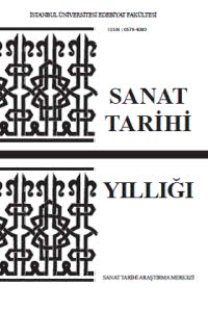Bekâretin Korunması Adına Erkek Benzeri Olmak ve Tanrı’nın Kadına Lütfu ‘Sakal’: Azize Wilgefortis (Virgo Fortis) Kültü ve İkonografik Zemini
Azize Wilgefortis, Azize Kümmernis, Volto Santo, Ortaçağ Sanatı, İkonografi
Impersonating a Male with a “Beard” in the Protection of Virginity as God's Grace to Women: The Cult of Saint Wilgefortis (Virgo Fortis) and its Iconographic Background
Saint Wilgefortis, Saint Kummernis, Volto Santo, Medieval Art, Iconography,
___
- Acta Sanctorum, 32, Temmuz 5, “De S. Liberata Alias Wilgeforte; Virgine et Martyre”,50-70. Erişim 20.01.2022 https://archive.org/details/actasanctorum32unse/page/n87/mode/2up google scholar
- Amstrong, Karen. “The Acts Of Paul And Thecla”, Feminist Theology: A Reader. Ed. Ann Loades. Westminster John Knox Press. (1990): 83-90. google scholar
- Barr, Jane. “The Influence Of Saint Jerome On Medieval Attitudes”. After Eve. Ed. Janet Martin Soskice. Marshall Pickering. (1990): 89-103. google scholar
- Barr, Jane. “The Vulgate Genesis And Jerome’s Attitudes To Women”.Studia, Patristica, 18. Oxford-New York: Pergamon Press. (1982): 1-20. google scholar
- Bart, Anneke.”Ancient Egypt-Hatshepsut (Maatkare)”, Saint Louis University Digital Archive, (2007). Erişim 20.01.2022. https://mathstat.slu.edu/~bart/egyptianhtml/kings%20and%20Queens/Hatshepsut.html https://web.archive.org/web/20080720162329/http://euler.slu.edu/Dept/Faculty/bart/egyptianhtml/kings%20 and%20Queens/Hatshepsut.html google scholar
- Bovey, Alixe. “Women In Medieval Society”, University Of Kent, The Courtauld Instiute Of Art, British Library Articles, (2015). Erişim 20.01.2022. https://www.bl.uk/the-middle-ages/articles/women-in-medieval-society# google scholar
- Casagrande, Carla. “Günah ve Felsefe”, Ortaçağ; Katedraller, Şövalyeler, Şehirler. Ed. Umberto Eco. Çev. Leyla Tonguç Basmacı. 317-323. İstanbul: Alfa Yayınları, 2012. google scholar
- Castex, Raymond P. Sainte Livrade: Etude Historique Et Critique Sur Sa Vie, Son Martyre, Ses Reliques Et Son Culte. Lille: Societe De Saint-Augustin, 1890. Erişim 20.01.2022. https://gallica.bnf.fr/ark:/12148/ bpt6k6567162p/f7.item.r=wilgeforte google scholar
- Cahier, P.Charles. Caracteristiques Des Saints Dans L’ art Populaire.1. Paris: Librairie Pousielque Freres,1867. Erişim 20.01.2022. https://bibliotheque-numerique.inha.fr/ viewer/5468/?offset=#page=3&viewer=picture&o=bookmark&n=0&q= google scholar
- Christ, Gina Lea. “The Thecla Narrative: Gender, Eschatology, And Divine Patronage in Second Century Social-Sexual Identity”. Yüksek Lisans Tezi. Saint Catherine University, 2013 Erişim 20.01.2022. google scholar
- https://sophia.stkate.edu/ma_theology/3/?utm_source=sophia.stkate.edu%2Fma_theology%2F3&utm_ medium=PDF&utm_campaign=PDFCoverPages google scholar
- Cuozzo, Errico. “Dine Adanma”. Ortaçağ; Katedraller, Şövalyeler, Şehirler. Ed. Umberto Eco. Çev. Leyla Tonguç Basmacı. 239-243. İstanbul: Alfa Yayınları, 2012. google scholar
- Delehaye, Pere Hippolyte. The Legends Of The Saints: An Introduction To Hagiography, S.J., BollandiSaint Çev. V. M. Crawford, 1961. Erişim 20.01.2022 https://sourcebooks.fordham.edu/basis/delehaye-legends.asp google scholar
- Fiocchi, Claudio. “Aydın Kadınlar”. Ortaçağ; Katedraller, Şövalyeler, Şehirler. Ed. Umberto Eco. Çev. Leyla Tonguç Basmacı. 312-317. İstanbul: Alfa Yayınları, 2012. google scholar
- Friesen, Ilse E. The Female Crucifix: Images Of Saint Wilgefortis Since The Middle Ages. Waterloo: Wilfrid Laurier Univ. Press. 2001. google scholar
- Great Gregory, Dialogues 4:13, Erişim 20.01.2022. https://www.tertullian.org/fathers/gregory_04_dialogues_ book4.htm#C13 google scholar
- Jensen, Anne. Thecla-die Apostolin: Ein Apokrypher Text Neu Entdeckt. Freiburg: Herder, 1995. google scholar
- Jastrow, Morris. “The Bearded Venus.” RevueArcheologique. 17. (1911): 271-298. Erişim 20.01.2022. http:// www.jstor.org/stable/41021741. google scholar
- Kaelber, Walter O. “Asceticism”, Encyclopedia Of Religion, 2. 1. Detroit: Thomson/Gale, 2005. google scholar
- Kaya, Mustafa. “Platon’un Ruh Kuramı”. Afyon Kocatepe Üniversitesi Sosyal Bilimler Dergisi. 15.1. (2013): 171-182. DOI : 10.5578/JSS.6784 google scholar
- Kempis, Thomas A. The Imitation Of ChriSaint Çev. William Benham. Project Gutenberg,1999. Erişim 20.01.2022 http://www.gutenberg.org/ebooks/1653 google scholar
- Letters Of Saint Jerome, Erişim 20.01.2022 https://www.newadvent.org/fathers/3001.htm google scholar
- Martinelli, Stefano. L’immagine Del Volto Santo Di Lucca; Il Successo Europeo Di Un’iconografia Medievale, Edizioni ETS, Pisa, 2016. google scholar
- Martinelli, Stefano. “The Volto Santo Of Lucca: An Iconographical And Devotional Theme In East-Central Europe.” Art Around 1400: Global And Regional Perspectives. (2012): 173-177 google scholar
- Martyrologium Romanum. Temmuz 20. E 7. Venetiis Typis Franciscis, N. Pezzana. University Of Toronto, 1784. Erişim 20.01.2022 https://archive.org/details/martyrologiumrom00cath/page/136/mode/2up google scholar
- Michel, Thomas. Hristiyan Tanrı Bilimine Giriş. İstanbul: Sak Yayıncılık,2012. google scholar
- Myres, J. N. L. “Pelagius And The End Of Roman Rule in Britain.” JRS-Journal Of Roman Studies, 50,1-2 (1960): 21-36. doi:10.2307/298284. Erişim 20.01.2022 www.jstor.org/stable/298284 google scholar
- Reau, Louis. Iconographie De L’art Chretien; Iconographie Des Saints. 3. Paris: Presses Universitaires De France, 1959. Erişim 20.01.2022 https://gallica.bnf.fr/ark:/12148/bpt6k33646394/f15.item.texteImage google scholar
- Schnürer, Gustav ve Ritz, Joseph Maria. “Sankt Kümmernis Und Volto Santo; Studien Und Bilder.” Zeitschrift Für Volkskunde. Ed. Fritz Boehm, 4. 42. Berlin: Walter De Gruyter & Co, (1933): 270-272. Erişim 20.01.2022 https://www.digi-hub.de/viewer/image/DE-11-001929014/290/LOG_0043/ google scholar
- Tarakçı, Muhammet. Felsefe Ansiklopedisi. 6. Ed. Ahmet Cevizci. 830-832. Ankara: Ebabil Yayıncılık, 2009. google scholar
- Tümer, Günay. “Asli Günah”. TDV İslam Ansiklopedisi. 3. 496-497. Türkiye Diyanet Vakfı Yayınları, 1991. google scholar
- “The Acts Of Paul And Thecla”. Çev. Jeremiah Jones. Erişim. 20.01.2022: https://www.ccel.org/ccel/schaff/ anf08.vii.xxvi.html google scholar
- Villemur, Frederique. “Saintes Et Travesties Du Moyen Âge”. Clio; Histoire, Femmes Et Societes. (1999) erişim 20.01.2022 https://journals.openedition.org/clio/253 google scholar
- Voragine, Jacobus D. The Golden Legend. Çev. William Caxton. Cambridge: Cambridge University Press, 1914. Erişim 20.01.2022 http://www.intratext.com/ixt/ENG1293/https://sourcebooks.fordham.edu/basis/ goldenlegend/goldenlegend-volume5.asp google scholar
- Williams, David. Deformed Discourse: The Function Of The Monster in Mediaeval Thought And Literature. Mcgill-Queen’s Press - MQUP. 1999. google scholar
- ISSN: 0579-4080
- Yayın Aralığı: 1
- Başlangıç: 1964
- Yayıncı: İstanbul Üniversitesi
Niğde/Tyana (Kemerhisar) Kazısı Türk-İslam Dönemi Seramikleri
Bizans Sanatında Şofar ve Trompet
Beçin Kalesi Kazısında Ortaya Çıkarılan (2014-2021) Tek Renk Sırlı Seramik Kapların Form Özellikleri
Avrupa ve Türk Resim Sanatında Kırlangıç Balığı Temalı Natürmortlar
Osmanlı Matbuatının Sekiz Punto Nesih Yazı Karakteri ve Türk Hurufat Yapımcısı Mehmed Emin Efendi
Metamodernizm Dönemi Türk Resminde Şehrin Zihinsel İmgesi
Andrii ARTEMENKO, Yaroslava ARTEMENKO
“Sanatta Büyük Devrim”: Roger Fry’ın Bizantinizminin Yeniden Yorumlanması
Hacı Selim Ağa’nın Kitaplarından 1386 Tarihli Bir Mesnevî: Kitap Sever Bürokratlar ve Aileler
